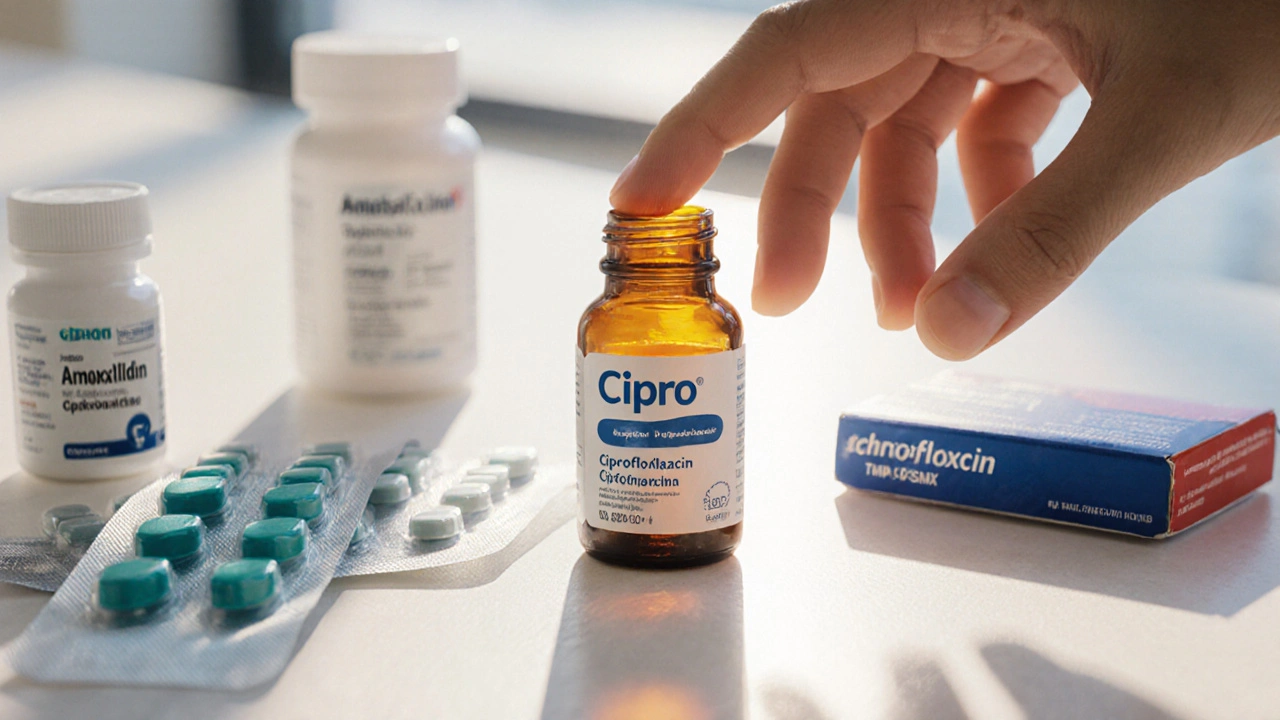
When you get a prescription for Ciprofloxacin, you might wonder if it’s really the right choice or if another pill could work better. Antibiotics are powerful tools, but they each have quirks-different bacteria they target, varying side‑effect profiles, and distinct safety warnings. This guide walks you through what Cipro does, compares it with the most common alternatives, and helps you figure out when to stick with it or consider something else.
Key Takeaways
- Ciprofloxacin belongs to the fluoroquinolone class and is excellent for many gram‑negative infections but carries notable tendon‑rupture and CNS warnings.
- Levofloxacin offers a similar spectrum with once‑daily dosing, while amoxicillin covers gram‑positive bugs and is gentler on the gut.
- Azithromycin shines for atypical and intracellular pathogens, and TMP‑SMX (trimethoprim‑sulfamethoxazole) is a go‑to for urinary‑tract infections and certain skin infections.
- Resistance patterns and patient‑specific factors (age, kidney function, pregnancy) should drive the final choice.
- Cost and insurance coverage vary; generic Cipro is usually cheap, but newer agents may be pricier.
What is Ciprofloxacin?
Ciprofloxacin is a synthetic fluoroquinolone antibiotic that interferes with bacterial DNA gyrase, preventing replication and leading to cell death. Marketed under the brand name Cipro, it was approved by the FDA in 1987 and quickly became a workhorse for urinary‑tract infections, gastrointestinal infections, and certain respiratory bugs.
Typical adult dosing ranges from 250mg to 750mg twice daily, depending on the infection type and severity. It’s available in tablets, oral suspension, and IV form, making it versatile for both outpatient and inpatient settings.
Why Compare? The Need for Alternatives
Even though Cipro is broad‑spectrum, it’s not a universal fit. The FDA has issued black‑box warnings about tendon rupture, peripheral neuropathy, and potential exacerbation of myasthenia gravis. Moreover, rising fluoroquinolone resistance in Gram‑negative bacteria has forced clinicians to look elsewhere.
Choosing an alternative means balancing effectiveness, safety, and patient convenience. Below we break down four popular options.
Levofloxacin: The Close Cousin
Levofloxacin is also a fluoroquinolone, but it offers once‑daily dosing for many indications, which can improve adherence. Its spectrum overlaps with Cipro, covering most gram‑negative and many gram‑positive organisms, but it has slightly better activity against Streptococcus pneumoniae.
Side‑effect profile mirrors Cipro’s-tendon risk and CNS effects-so the same cautions apply. Levofloxacin is often reserved when a once‑daily schedule is critical or when local resistance data suggest it outperforms Cipro.
Amoxicillin: The Gentle Giant
Amoxicillin belongs to the beta‑lactam class and is one of the most prescribed antibiotics worldwide. It works by inhibiting bacterial cell‑wall synthesis, making it especially effective against gram‑positive organisms like Streptococcus and certain Haemophilus strains.
Unlike fluoroquinolones, amoxicillin is generally safe for children and pregnant women, and it carries a low risk of serious adverse events. However, it’s not suitable for many gram‑negative infections where Cipro shines, and resistance in Enterobacteriaceae is rising.

Azithromycin: The Long‑Acting Macrolide
Azithromycin is a macrolide that binds to the 50S ribosomal subunit, halting protein synthesis. It’s prized for its long half‑life, allowing a three‑day course to treat conditions that traditionally required a week of therapy.
Azithromycin excels against atypical pathogens (Mycoplasma, Chlamydia) and intracellular bacteria (Legionella). It’s also useful for patients who cannot tolerate fluoroquinolones. Side effects are usually mild-nausea, diarrhea, mild QT prolongation-but it can interact with drugs that affect cardiac rhythm.
Trimethoprim‑Sulfamethoxazole (TMP‑SMX): The Dual‑Action Duo
Trimethoprim‑sulfamethoxazole, often called Bactrim or Septra, combines two agents that block successive steps in bacterial folate synthesis. This double‑hit makes it effective for urinary‑tract infections, certain skin infections, and prophylaxis against Pneumocystis jirovecii.
It’s generally well‑tolerated but can cause hypersensitivity reactions, especially in patients with sulfa allergy. Renal impairment requires dose adjustment, and it should be avoided in late pregnancy due to risk of kernicterus.
How the Drugs Stack Up: Quick Comparison Table
| Attribute | Ciprofloxacin (Cipro) | Levofloxacin | Amoxicillin | Azithromycin | TMP‑SMX |
|---|---|---|---|---|---|
| Drug class | Fluoroquinolone | Fluoroquinolone | Beta‑lactam (penicillin) | Macrolide | Combination sulfonamide |
| Typical spectrum | Broad gram‑negative, some gram‑positive | Broad gram‑negative, better gram‑positive | Gram‑positive, limited gram‑negative | Atypical, intracellular, some gram‑positive | Gram‑negative, some gram‑positive, MRSA (some strains) |
| Common uses | UTI, GI infections, bone/joint infections | Community‑acquired pneumonia, sinusitis | Otitis media, sinusitis, uncomplicated pneumonia | Chlamydia, Mycoplasma, traveler's diarrhea | UTI, skin infections, PCP prophylaxis |
| Dosing convenience | 2× daily (250‑750mg) | Once daily (500‑750mg) | 3× daily (250‑500mg) | Once daily (500mg) | 2× daily (800mg/160mg) |
| Key side effects | Tendon rupture, CNS effects, photosensitivity | Same as Cipro | Diarrhea, rash, rare anaphylaxis | GI upset, QT prolongation | Rash, hyperkalemia, renal toxicity |
| FDA warnings | Black‑box for tendons, CNS, aortic aneurysm | Black‑box similar to Cipro | None beyond standard | Boxed warning for QT prolongation | Boxed warning for severe skin reactions |
| Typical cost (US$) | 10‑15 (generic 14‑day) | 15‑20 | 5‑10 | 12‑18 | 8‑12 |
When Cipro Is Still the Best Choice
If you’re dealing with a complicated urinary‑tract infection caused by Pseudomonas aeruginosa or a severe gastrointestinal infection like traveler's diarrhea caused by Shigella, Cipro often outperforms the alternatives. Its ability to reach high tissue concentrations quickly makes it a go‑to for bone and joint infections where other agents may be slower.
Patients without tendon‑risk factors (no recent steroid use, not over 60, no uncontrolled diabetes) can safely use Cipro for short courses. Always pair the prescription with advice to avoid intense sun exposure and to stop the drug immediately if sudden joint pain or swelling occurs.

When to Switch to an Alternative
Consider swapping out Cipro in these scenarios:
- Age or comorbidity concerns: Elderly patients, pregnant women, or those with a history of tendon disorders should avoid fluoroquinolones.
- Known resistance: Local antibiograms showing high fluoroquinolone resistance in E. coli (>20%) warrant a different drug.
- Drug interactions: Patients on warfarin, certain antidiabetics, or medications that prolong QT should be steered toward amoxicillin or azithromycin, depending on infection type.
- Adverse reactions: Early signs of tendon pain, peripheral neuropathy, or severe GI upset signal a need to stop immediately and switch.
Practical Tips for Patients
- Ask the prescriber about the specific bacteria the antibiotic targets. Knowing the organism guides whether a broad‑spectrum drug like Cipro is necessary.
- Complete the full course, even if you feel better. Stopping early fuels resistance.
- Stay hydrated and avoid high‑impact sports while on fluoroquinolones to reduce tendon stress.
- If you’re on other meds, double‑check for interactions-especially with antacids, which can lower fluoroquinolone absorption.
- Keep a copy of your local antibiogram (often available at hospitals) to discuss with your doctor if you suspect resistance.
Frequently Asked Questions
Can I take Ciprofloxacin if I’m pregnant?
Pregnancy is a red flag for fluoroquinolones. Animal studies show cartilage damage in developing joints, and human data are limited. Doctors usually switch to amoxicillin or azithromycin when safe alternatives exist.
Why do I feel dizzy after taking Cipro?
Dizziness can be a CNS side effect of fluoroquinolones. It’s worth mentioning to your prescriber, especially if it’s severe or paired with visual changes.
Is a short 3‑day course of azithromycin as effective as a 7‑day course of Cipro?
For infections caused by susceptible organisms (e.g., Chlamydia), azithromycin’s long half‑life makes a 3‑day regimen just as effective. For gram‑negative UTIs, Cipro’s pharmacokinetics require a longer course.
What should I do if I develop tendon pain while on Cipro?
Stop the medication immediately, rest the affected area, and contact your healthcare provider. They’ll likely prescribe an alternative antibiotic and may order imaging to assess tendon health.
How does antibiotic resistance affect my choice of Cipro?
If local resistance rates for fluoroquinolones exceed 20‑30% for the suspected bug, guidelines recommend a different class. Ask your doctor for the most recent antibiogram data.
Bottom Line: Choose Wisely, Use Responsibly
There’s no one‑size‑fits‑all answer. Cipro remains a potent option for certain tough infections, but its safety profile forces a careful risk‑benefit analysis. By understanding how it compares to levofloxacin, amoxicillin, azithromycin, and TMP‑SMX, you can have an informed conversation with your clinician and pick the drug that best matches your infection, health status, and lifestyle.





Comments (14)
king singh
Thanks for the thorough breakdown. It's helpful to see the side‑effect profile of Cipro laid out alongside the alternatives. I especially appreciate the practical tips about staying hydrated and avoiding intense sports while on fluoroquinolones. This kind of patient‑focused guidance makes the decision process clearer.
Michelle Dela Merced
Wow, Cipro sounds like a superhero with a dark side! 🤯💊
Alex Iosa
From an ethical standpoint, prescribing a drug with known tendon‑rupture risks warrants a rigorous risk‑benefit analysis. Physicians must disclose the black‑box warnings transparently and obtain informed consent. Moreover, the growing resistance to fluoroquinolones underscores the responsibility to reserve Cipro for infections where no safer alternative exists. Ignoring these considerations could be viewed as a lapse in professional duty.
melissa hird
Ah, the ever‑so‑gentle reminder that “once‑daily dosing” magically absolves us of any safety concerns-how delightfully naive. While the convenience is noted, the underlying tendon and CNS warnings remain unabated. One might as well applaud the marketing team for their optimism rather than the drug’s pharmacology. In short, convenience does not override caution.
Mark Conner
Look, folks, we’ve got a home‑grown antibiotic that can take on tough gram‑negative bugs, and it’s cheap as chips-perfect for keeping our healthcare costs down. We shouldn’t let overseas “regulators” scare us off just because they love paperwork. If you’re healthy and follow the guidelines, Cipro is a solid choice for America’s battle against infections.
Charu Gupta
While the article accurately delineates the pharmacodynamics of ciprofloxacin, it omits the necessity of adhering to proper administration timing, especially with antacids. Patients should be reminded to separate dosing by at least two hours to ensure optimal absorption. Additionally, the potential for photosensitivity necessitates sunscreen usage during prolonged exposure. 📚✅
Abraham Gayah
Honestly, this whole “compare antibiotics” saga feels like a pretentious academic exercise for people who can’t decide between a latte and a cappuccino. If you’re not a medical wizard, just follow the doctor’s script and stop overthinking.
rajendra kanoujiya
Everyone’s quick to champion fluoroquinolones, yet the data on long‑term cartilage damage in younger patients is still inconclusive. It might be wiser to default to beta‑lactams wherever feasible, sidestepping the tendon debate altogether.
Beverly Pace
It is morally incumbent upon clinicians to prioritize patient safety over pharmaceutical convenience. Prescribing Cipro without exhausting first‑line options could be construed as a breach of the Hippocratic oath. Ethical stewardship mandates a judicious, evidence‑based approach.
RALPH O'NEIL
The comparison chart succinctly highlights key differences, making it easier to match an infection to the appropriate agent. Notably, the cost disparity can influence patient adherence, especially in underinsured populations. Overall, the guide serves as a practical reference for both clinicians and patients.
Mark Wellman
Okay, let me break this down because there’s a lot to chew on when it comes to Cipro and its cousins. First off, the fluoroquinolone class, which includes both ciprofloxacin and levofloxacin, is notorious for causing some pretty gnarly side effects that most people don’t even think about until they’re in the thick of it. Tendon rupture, for instance, isn’t just a fancy phrase-it can literally sideline you for months, and the pain can feel like a snapped rope inside your ankle or shoulder. Then there’s the central nervous system stuff, which can manifest as dizziness, anxiety, even hallucinations in rare cases, and that’s not something you want messing with your day‑to‑day life. Now, about the spectrum: ciprofloxacin is a beast against gram‑negative bugs, but it kinda drops the ball on gram‑positives unless you’re dealing with specific strains. Levofloxacin tries to fill that gap a bit better, but it still carries the same red‑flag warnings, so you’re basically swapping one risk for another. Amoxicillin, on the other hand, is a gentler giant-easy on the gut, safe for kids and pregnant women, but it’s not gonna win a battle against Pseudomonas. Azithromycin shines when you’re up against atypical organisms like Mycoplasma, but its QT‑prolongation potential means you have to check the patient’s cardiac history first. TMP‑SMX is a solid choice for UTIs because it hits the folate pathway twice, but watch out for sulfa allergies and kidney issues. Cost is another big player; generic Cipro is cheap, which is why a lot of clinics default to it, but cheaper doesn’t always mean better for the patient’s long‑term health. Resistance patterns are shifting fast, especially in community settings where fluoroquinolone resistance can exceed 30%, making the drug less reliable. That’s why you need local antibiograms before you reach for that prescription pad. Also, drug–drug interactions are a minefield-antacids, calcium supplements, and some diabetic meds can knock down ciprofloxacin’s absorption, leaving you with sub‑therapeutic levels. Hydration is key; staying well‑watered reduces the risk of tendon issues, but that’s more of a precaution than a guarantee. If you do notice sudden joint pain while on the drug, stop immediately and get it checked-early detection can prevent a full‑blown rupture. For most uncomplicated UTIs, a short course of amoxicillin-clavulanate might do the trick without exposing you to the heavyweight risks of fluoroquinolones. In summary, Cipro is a powerful tool in the right hands and the right scenario, but it’s far from a one‑size‑fits‑all solution, and you’ve got to weigh the pros and cons carefully before hitting “prescribe”.
Amy Morris
I totally get how confusing the antibiotic landscape can feel, especially when you’re juggling side‑effects and cost. It’s reassuring to know that staying hydrated and avoiding high‑impact activities can mitigate tendon risks. If you ever feel dizzy while on Cipro, reaching out to your provider promptly is the safest move. Remember, you’re not alone in navigating these choices-many patients share the same concerns.
Francesca Roberts
Pro tip: always double‑check the expiration date on your ciprofloxacin bottle-nothing kills a bacterial infection faster than a stale pill. Also, if you’re taking antacids, separate them by at least two hours; otherwise, you’re just wasting money. And hey, if you’re looking for a “quick fix,” maybe consider a different class-Cipro isn’t the miracle cure for everything, despite what the ads might imply.
Becky Jarboe
The pharmacokinetic profile of ciprofloxacin demonstrates a high volume of distribution, facilitating tissue penetration in osteoarticular compartments. However, its propensity for inducing CYP1A2 inhibition may precipitate drug‑drug interactions, especially with concomitant theophylline therapy. From a stewardship perspective, deploying Cipro should be contingent upon confirmed susceptibility, as empirical use accelerates resistance selection pressure. Integrating local antibiogram data into the decision matrix optimizes therapeutic outcomes while preserving antimicrobial efficacy.